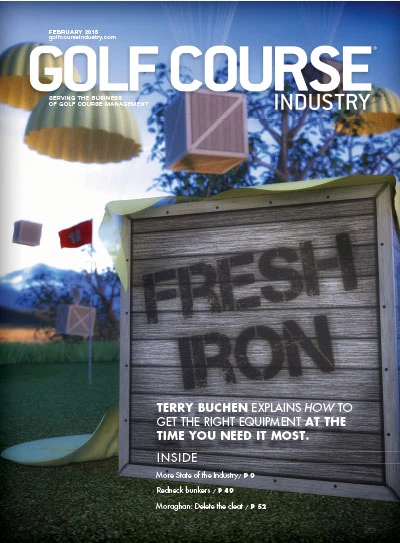
 Tim Moraghan Tim Moraghan | I’m usually a big proponent of technology, of adopting new equipment and ideas to make golf better. However, we need to reconsider one of the most significant changes of the past few decades in light of evidence that is most obvious to us, green superintendents. It may be time to take a hard line against soft spikes. About 20 years ago, there was a major revolution in golf. The 6- to 8-mm metal spike was replaced by the plastic “soft spike” following an uproar about the damage that metal spikes were doing to turfgrass, particularly putting greens. Fast forward to today and take a look at the bottom of golf shoes. Actually, if you’re a superintendent, you don’t have to examine the shoes themselves: Walk on any green and you’ll easily see how spike technology has changed. These “soft” spikes are getting longer, sharper, wider and more aggressive, so as a result, they are inflicting more and more damage on our courses. The same week that the golf industry was convening – and showing off a host of new shoe styles – at the PGA Show in Florida, I conducted a random survey of superintendents, asking them how plastic spikes have affected them. While the shoe manufacturers were introducing soles with more spikes and other “points of contact” (POCs) designed to give golfers better traction and stability, I received these comments from some of our brethren. “It is no secret that golf has been on the decline for the last 5-plus years, yet the demand for conditioning, with fast and firm greens, has increased,” wrote one superintendent. “Why do shoe manufactures continue to produce shoes that do everything to frustrate other golfers and those that are employed to provide the conditions? The firmest, driest greens do not withstand a foursome of golfers wearing these types of spikes. The scuffing, unintentional scuffing, and twisting of turf, especially around the cup, ruins the putting surface for every golfer that follows.” “Some of the newer spikes are so aggressive – long, tall, robust – we are seeing scuff marks and scars on the greens,” someone told me. “Rather than pressing into the turf, these new spikes seem to grab and hold onto the turf, causing more shearing and tearing of low-cut grass. When feet twist and turn, it’s almost as if the spikes are ‘reverse ball repair tools.’” You can quickly see the main themes in these comments, which were repeated in the many others I received: the new spikes are doing more damage at a time when golf is already in trouble, and that damage is at least as bad as what metal spikes used to do. Shoes used to have eight or nine metal spikes. Now shoes have six to 12 “spikes” each with five or so prongs, plus dozens, sometimes hundreds more points of contact of various sizes, depths, and sharpness. Adidas has a new shoe with 18 spikes, each of those spikes has five POCs, so that’s 180 impressions from each golfer with every step. This extra damage increases maintenance costs – chemicals, topdressing sand and additional staff to maintain turf quality. Depending on the region and the weather, the damage can be exaggerated when it’s wet (in the Northwest), hot (stressed turf in the Northeast and central states), and on dormant grass (Southeast, Florida). Early and late in the season, growth can be severely compromised by damage to the plant. What can we do? The GCSAA needs to push the USGA and PGA of America, as well as the manufacturers, to evaluate the damage incurred by these “soft” spikes. In the meantime, some suggestions for the individual superintendent:
When soft spikes became the norm, courses were quick to tell golfers that they couldn’t wear metal spikes. We need a new educational initiative – backed by shoe manufacturers and all the organizations responsible for growing, protecting and enhancing the game. The “soft” spike is making it “hard” for all of us to enjoy the game. It’s time to delete the cleat.
Tim Moraghan, principal, ASPIRE Golf (tmoraghan@aspire-golf.com). Follow Tim’s blog, Golf Course Confidential on Twitter @TimMoraghan |

Explore the February 2015 Issue
Check out more from this issue and find your next story to read.
Latest from Golf Course Industry
- From the publisher’s pen: Conscientious of a bigger role
- Bernhard and Company partners with Laguna Golf Phuket
- Terre Blanche showcases environmental stewardship
- VIDEO: Introducing our December issue
- Bernhard and Company introduces Soil Scout
- Nu-Pipe donates to GCSAA Foundation’s Centennial Campaign
- GCSAA enhances golf course BMP tool
- Melrose leadership programs sending 18 to 2026 GCSAA Conference and Trade Show






